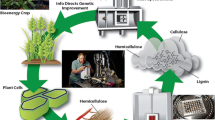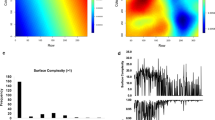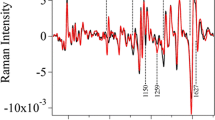Abstract
Pyrolysis molecular-beam mass spectrometry (PyMBMS) was tested as a high-throughput method for relative abundances of guaiacyl and syringyl lignin in lignocellulosic cell-wall materials from stems of a population of maize intermated B73 × Mo17 (IBM) recombinant inbred lines. Variations of up to twofold across the population in phenylpropanoid abundance were observed. Several histochemical and quantitative biochemical assays were used to validate the mass spectrometric data for lignin, hydroxycinnamic acids, crystalline cellulose, non-cellulosic glucans, and xylans. We demonstrate PyMBMS to be a valid high-throughput screen suitable for analysis of lignin abundance in large populations of bioenergy grasses. Pentose from xylans and hexose from cellulosic and non-cellulosic glucans also varied substantially across the population, but abundances of diagnostic fragments for these monosaccharides were not well correlated with the abundance of cell-wall polysaccharides.








Similar content being viewed by others
Abbreviations
- PyMBMS:
-
Pyrolysis molecular-beam mass spectrometry
- IBM:
-
Intermated B73 × Mo17 recombinant inbred population
- GAX:
-
Glucuronoarabinoxylan
- G-lignin:
-
Guaiacyl-lignin
- H-lignin:
-
p-Hydroxyphenol-lignin
- RIL:
-
Recombinant inbred line
- QTL:
-
Quantitative trait locus (loci)
- S-lignin:
-
Syringyl-lignin
References
Dweikat I, Weil C, Moose S, Kochian L, Mosier N, Ileleji K et al (2012) Envisioning the transition to a next-generation biofuels industry in the US Midwest. BioFPR 6:376–386
Romay MC, Millard MJ, Glaubitz JC, Peiffer JA, Swarts KL, Casstevens TM et al (2013) Comprehensive genotyping of the USA national maize inbred seed bank. Genome Biol 14:R55
Liu K, Goodman M, Muse S, Smith JS, Buckler ES, Doebley J (2003) Genetic structure and diversity among maize inbred lines as inferred from DNA microsatellites. Genetics 165:2117–2128
Flint-Garcia S, Thullet A-C, Yu J, Pressoir G, Romero SM, Mitchell SE, Doebley J, Kresovich S, Goodman MM, Buckler ES (2005) Maize association population: a high-resolution platform for quantitative trait locus dissection. Plant J 44:1054–1064
Bradbury PJ, Zhang Z, Kroon DE, Casstevens TM, Ramdoss Y, Buckler ES (2007) TASSEL: software for association mapping of complex traits in diverse samples. Bioinformatics 23:2633–2635
Lee M, Sharopova N, Beavis WD, Grant D, Katt M et al (2002) Expanding the genetic map of maize with the intermated B73 × Mo17 (IBM) population. Plant Mol Biol 48:453–461
Sharopova N, McMullen M, Schultz L, Schroeder S, Sanchez-Villeda H, Gardiner J et al (2002) Development and mapping of SSR markers for maize. Plant Mol Biol 48:463–481
Yu J, Holland JB, McMullen MD, Buckler ES (2008) Genetic design and statistical power of nested association mapping in maize. Genetics 178:539–551
Evans RJ, Milne TA (1987) Molecular characterization of the pyrolysis of biomass. 1. Fundamentals. Energ Fuels 1:123–137
Boon JJ (1989) An introduction to pyrolysis mass spectrometry of lignocellulosic material: case studies of barley straw, corn stem and Agropyron. In: Chesson A, Ørskov ER (eds) Physicochemical characterization of plant residues for industrial feed use. Elsevier Applied Science, Amsterdam, pp 25–49
Tuskan G, West D, Bradshaw HD, Neale D, Sewell M, Wheeler N et al (1999) Two high-throughput techniques for determining wood properties as part of a molecular genetics analysis of hybrid poplar and loblolly pine. Appl Biochem Biotechnol 77–79:55–65
Yin T, Zhang X, Gunter L, Priya R, Sykes R, Davis M, et al. (2010) Differential detection of genetic loci underlying stem and root lignin content in Populus. PLoS One 5: Art. No. e14021.
Mann DGJ, Labbé N, Sykes RW, Gracom K, Kline L, Swamidoss IM et al (2009) Rapid assessment of lignin content and structure in switchgrass (Panicum virgatum L.) grown under different environmental conditions. Bioenerg Res 2:246–256
Carpita NC (1996) Structure and biogenesis of the cell walls of grasses. Annu Rev Plant Physiol Plant Mol Biol 47:445–476
Carpita NC, Gibeaut DM (1993) Structural models of primary cell walls in flowering plants: consistency of molecular structure with the physical properties of the walls during growth. Plant J 3:1–30
Barrière Y, Riboulet C, Méchin V, Maltese S, Pichon M, Cardinal A et al (2007) Genetics and genomics of lignification in grass cell walls based on maize as model species. Genes, genomics, and genetics. Global Science Books, In, pp 133–156
Vanholme R, Demedts B, Morreel K, Ralph J, Boerjan W (2010) Lignin biosynthesis and structure. Plant Physiol 153:895–905
Sykes R, Kodrzycki B, Tuskan G, Foutz K, Davis M (2008) Within tree variability of lignin composition in Populus. Wood Sci Technol 42:649–661
Edwards AL (1976) The correlation coefficient. An introduction to linear regression and correlation. WH Freeman, San Francisco, In, pp 33–46
Mecklin C (2007) Shapiro–Wilk test for normality. In: Salkind N (ed) Encyclopedia of measurement and statistics. SAGE Publications, Thousand Oaks, CA, pp 884–887
Sindhu A, Langewisch T, Olek A, Multani DS, McCann MC, Vermerris W et al (2007) Maize Brittle stalk2 encodes a COBRA-like protein expressed in early organ development but required for tissue flexibility at maturity. Plant Physiol 145:1444–1459
Theander O, Westerlund EA (1986) Studies on dietary fiber. 3. Improved procedures for analysis of dietary fiber. J Agric Food Chem 34:330–336
Hatfield RD, Jung HJG, Ralph J, Buxton DR, Weimer PJ (1994) A comparison of the insoluble residues produced by the Klason lignin and acid detergent lignin procedures. J Sci Food Agric 65:51–58
Hemm MR, Ruegger MO, Chapple C (2003) The Arabidopsis ref2 mutant is defective in the gene encoding CYP83A1 and shows both phenylpropanoid and glucosinolate phenotypes. Plant Cell 15:179–194
Hedges JI, Mann DC (1979) Characterization of plant tissues by their lignin oxidation products. Geochim Cosmochim Acta 43:1803–1807
Hedges JI, Ertel JR (1982) Characterization of lignin by gas capillary chromatography of cupric oxide oxidation-products. Anal Chem 54:174–178
Filley TR, Boutton TW, Liao JD, Jastrow D (2008) Chemical changes to non-aggregated particulate soil organic matter following grassland-to-woodland transition in a subtropical savanna. J Geophys Res 113, G03009
Dubois M, Gilles KA, Hamilton JK, Rebers PA, Smith F (1956) Colorimetric method for determination of sugars and related substances. Anal Chem 28:350–356
Updegraff D (1969) Semimicro determination of cellulose in biological materials. Anal Biochem 32:420–424
Gibeaut DM, Carpita NC (1991) Tracing cell-wall biogenesis in intact cells and plants. Selective turnover and alteration of soluble and cell-wall polysaccharides in grasses. Plant Physiol 97:551–561
Pomar F, Merino F, Barceló AR (2002) O-4-Linked coniferyl and sinapyl aldehydes in lignifying cell walls are the main targets of the Wiesner (phloroglucinol-HCl) reaction. Protoplasma 220:17–28
Venkatakrishnan VK, Degenstein JC, Smeltz AD, Delgass WN, Agrawal R, Ribeiro FH (2013) High pressure fast-pyrolysis, fast-hydropyrolysis and catalytic hydrodeoxygenation of cellulose: Production of liquid fuel from biomass. Green Chemistry, in press.
Agblevor FR, Evans RJ, Johnson KD (1994) Molecular-beam mass-spectrometric analysis of lignocellulosic materials. 1. Herbaceous biomass. J Anal Appl Pyrolysis 30:125–144
Ralph J, Hatfield RD (1991) Pyrolysis-GC–MS characterization of forage materials. J Agric Food Chem 39:1426–1437
Mueller-Harvey I, Hartley RD, Harris PJ, Curzon EH (1986) Linkage of p-coumaroyl and feruloyl groups to cell-wall polysaccharides of barley straw. Carbohydr Res 148:71–85
Ralph J, Hatfield RD, Quideau S, Helm RF, Grabber JH, Jung HJG (1994) Pathway of p-coumaric acid incorporation into maize lignin as revealed by NMR. J Am Chem Soc 116:9448–9456
Grabber JH, Hatfield RD, Ralph J, Zon J, Amrhein N (1995) Ferulate cross-linking in cell walls isolated from maize cell suspensions. Phytochemistry 40:1077–1082
Davis MF, Tuskan GA, Payne P, Tschaplinski TJ, Meilan R (2006) Assessment of Populus wood chemistry following the introduction of a Bt toxin gene. Tree Physiol 26:557–564
Penning BW, Sykes WR, Babcock NC, Dugard CK, Held MA, Klimek JF, et al. (2013) Quantitative trait loci contributing to phenylpropanoid abundance are different from those for saccharification yield in a maize recombinant inbred population. In review.
Acknowledgments
We thank Steve Moose, University of Illinois, for providing access to the maize stover and helpful discussions. Multiyear sampling of the IBM population was supported by the U.S. Department of Energy Feedstock Genomics Program, Office of Biological and Environmental Research, Office of Science; screening of the IBM population by PyMBMS was supported by the BioEnergy Science Center a U.S. Department of Energy Bioenergy Research Center supported by the Office of Biological and Environmental Research in the DOE Office of Science Contract No. DE-AC36-08-GO28308, and by the National Science Foundation “Hy-Bi”, an Emerging Frontiers in Research and Innovation (EFRI) program, Award No. 0938033; histochemical and analytical validations of PyMBMS for lignin and carbohydrate abundance were supported by the Center for Direct Catalytic Conversion of Biomass to Biofuels (C3Bio), an Energy Frontier Research Center funded by the U.S. Department of Energy, Office of Science, Office of Basic Energy Sciences, Award Number DE-SC0000997.
Author information
Authors and Affiliations
Corresponding author
Electronic Supplementary Material
Below is the link to the electronic supplementary material.
Supplemental Table S1
(DOCX 94.4 kb)
Rights and permissions
About this article
Cite this article
Penning, B.W., Sykes, R.W., Babcock, N.C. et al. Validation of PyMBMS as a High-throughput Screen for Lignin Abundance in Lignocellulosic Biomass of Grasses. Bioenerg. Res. 7, 899–908 (2014). https://doi.org/10.1007/s12155-014-9410-3
Published:
Issue Date:
DOI: https://doi.org/10.1007/s12155-014-9410-3




